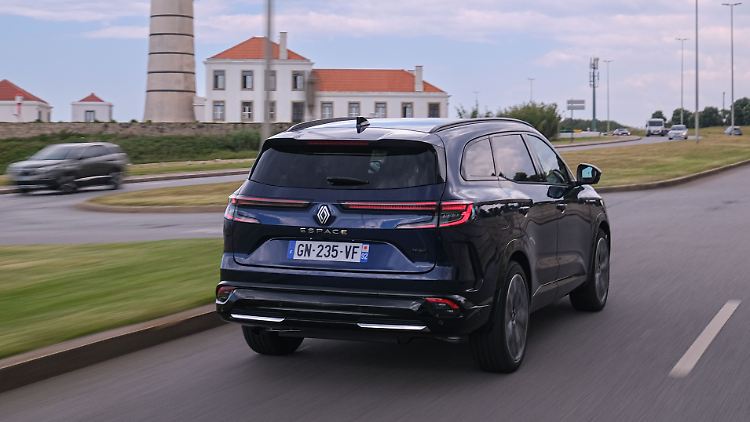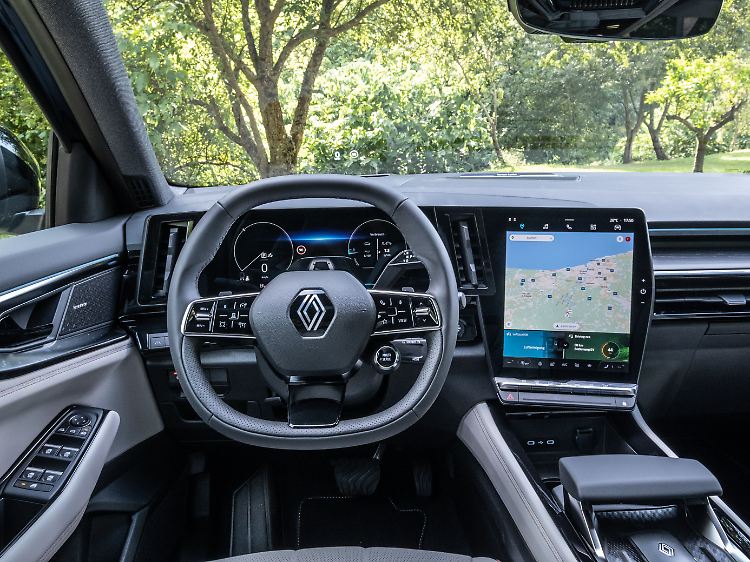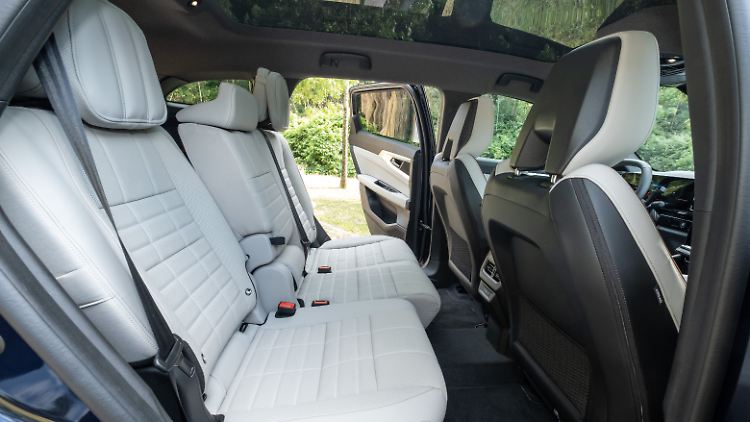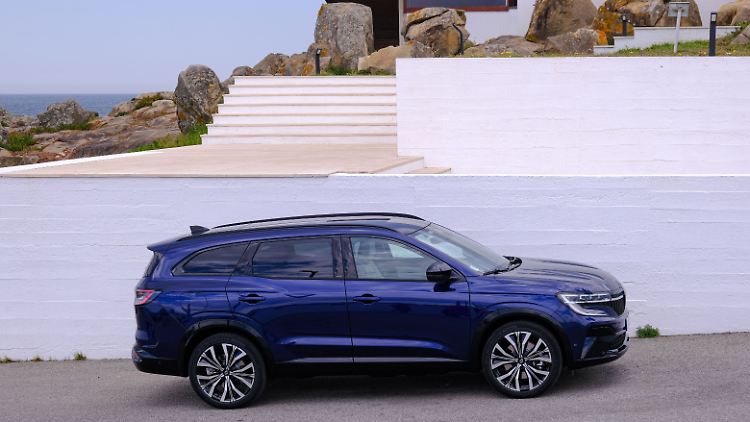Economical drive, modern ambience
Renault Espace E-Tech Full Hybrid 200 – SUV in the test
This audio version was artificially generated. More info | Send feedback
Large vans are a dying breed. Even the founder of the family car class is turning away from this body concept; the Renault Espace is now an SUV. Is this a good idea?
The Euro van pioneer has become a boring SUV. That can be regretted. Or simply enjoy the modern ambience and efficient drive of the new Renault Espace. At least the Frenchman doesn't need to hide from his peers thanks to his distinctive character.


The long wheelbase and the responsive suspension iron out a lot.
(Photo: Renault)
The now sixth generation has moved as far away as possible from the avant-garde original Espace of the 1980s. Number five already played with crossover elements, the current model is now a classic SUV in the style of Skoda Kodiaq, Kia Sorento and Nissan X-Trail. It shares the platform and some of the technology with the latter, which can hardly be guessed from the outside and not at all from the inside.
Modern interior and lots of space


The Renault Espace has a modern interior with large display areas and few buttons.
(Photo: Renault)
Where the Nissan relies on more dignified, classic furnishings, the Renault has a decidedly modern interior with large display areas and few buttons. The infotainment is operated via the touchscreen or the very intelligent Google voice assistant. In general, we like the on-board software from the US IT giant, which also includes the Maps map service, which functions as a navigation system. Overall, the infotainment is complex and full of submenus. Because important functions such as the air conditioning are still controlled via manual switches, basic operation is easy.
If you let your attention wander from the cockpit towards the rear and luggage compartment, you will notice the generous amount of space. Five people sit very comfortably and airy. The optional panoramic glass roof does not noticeably restrict headroom. Many well-sized shelves and several USB ports for cell phones etc. also ensure convenience and family travel comfort.
Renault Espace is one of the more spacious SUVs


The trunk of the Renault Espace holds between 581 and 1714 liters.
(Photo: Renault)
The trunk is quite spacious for its class and holds up to 1417 liters with the rear seat folded down. If you need more space for passengers, you can fold out two emergency seats, which are offered at no extra charge. Thanks to the tolerably large footwell, even a medium-sized adult can sit in them surprisingly well – at least on short journeys. A real test of flexibility, however, is getting into row three, past the folded backrests of the front seats.
Even though the new Espace is one of the more spacious SUVs on the market, it can no longer keep up with the space and variability of the first generations. At least the back seat can be moved lengthwise in order to adapt the division between the passenger and luggage compartments to current needs.


There is also enough space in the rear.
(Photo: Renault)
What is also noticeable is the significantly poorer overview – instead of large van windows, there are high SUV shoulders and rather small glass surfaces that restrict the view to the rear.
Agile, handy and fairly shakeproof
On the other hand, the chassis comfort is at the usual level. The long wheelbase and the responsive suspension iron out even the worst creased asphalt at cruising speeds; the large 20-inch wheels (optional) only cope only moderately well with poorly maintained city streets. The new Espace does without the sponginess and sluggishness that previously characterized many French cars. Instead, a steering rear axle (from “Esprit Alpine”) makes the large SUV appear quite agile and also ensures maneuverability when maneuvering.


Unique selling point in this class: the full hybrid drive of the Renault Espace.
(Photo: Renault)
A unique selling point in this class is the Espace's full hybrid drive, which has no alternative. Cooperation partner Nissan does not offer Renault technology in the X-Trail, instead relying on its serial hybrid drive called “E-Power”. The relatively complex design consisting of a 1.2-liter three-cylinder gasoline engine, two electric motors and a special transmission is designed for economy and the highest possible purely electric driving share. Both work quite well: on average, the drive makes do with just under 6 liters, even without the driver having to make any special efforts to save money. In city traffic, amazingly long distances can be covered without the combustion engine having to kick in even once. This is how the hybrid often shows its best side.
But the drive can also be different: the combustion engine and electric motor don't always work smoothly; sometimes the interaction seems downright erratic. The three-cylinder sometimes revs up suddenly and with an unpleasant acoustic sound, or both power sources do not agree on who should provide acceleration. The drive becomes hesitant, especially when the recommended speed is exceeded. At 174 km/h the propulsion finally stops.
Reasonably attractively priced
The not always harmonious and confident drive is now a small downer. Overall, the Espace impresses on the road, in terms of operation and in the ambience. At 44,760 euros, the five or seven-seater is also reasonably attractively priced. Especially since the equipment is already decent and also includes items such as navigation, electric tailgate and adaptive LED light. Anyone who adds another 3,000 euros will get the “Esprit Alpine” model, which has been visually enhanced and can then also be upgraded with further options such as a glass roof, head-up display or matrix LEDs.
Anyone who has more than four passengers these days and doesn't want to buy a minibus right away can't ignore a seven-seater SUV. In this case, the Renault Espace is certainly on the list of candidates with its economical hybrid and modern interior. The slight reduction in drive comfort can probably be tolerated by many buyers given the advantages.
Renault Espace E-Tech Full Hybrid 200 – technical data
- Five-door mid-range SUV
- Length: 4.72 meters, width: 1.84 meters (with exterior mirrors: 2.08 meters), height: 1.64 meters, wheelbase: 2.74 meters, trunk volume (5/7 seats): 581/159-1818 /1714 liters
- Full hybrid engine with 1.2 liter three-cylinder turbo petrol engine; 96 kW/131 hp plus two electric motors with 50 kW/68 hp and 18 kW/25 hp respectively; System output: 146 kW/199 HP, maximum torque: 230 Nm at 1750 rpm
- 0-100 km/h: 8.8 s, Vmax: 174 km/h
- Front-wheel drive, multi-mode automatic transmission with 2/4 speed levels (electric drive/combustion engine)
- Standard consumption: 4.6-4.9 liters/100 km, CO2 emissions: 106-110 g/km, test consumption: 6.0 liters/100 km
- Price: from 44,760 euros
































